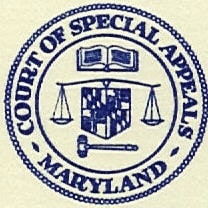Part 2 of Article on Maryland Weak Bad Faith Law
Click here for part one of this article
Maryland’s Bad Faith Law (Inexplicably) Does Not Apply to MAIF
Generally speaking, the statute of limitations in Maryland is applicable to first party breach of contract actions arising out of automobile collisions is not three years from the date of the collision, but three years from the date of the breach. This limitation was spelled out in the case of Pfeifer v Phoenix, 189 Md. App. 675 (2010). However, first party claims involving persons who are insured with the Maryland Automobile Insurance Fund warrant closer scrutiny.

In 1972, the Maryland General Assembly created the Maryland Automobile Insurance Fund (MAIF). A strange creature to say the least (we complain about MAIF throughout this website) and thanks to the Court of Appeals it apparently enjoys some form of immunity from first party contract claims. This immunity was described in the recent case of Daughton v. MAIF, 198 Md. App. 524 (2011). Daughton involved a declaratory judgment action and breach of contract action centered on MAIF’s failure to pay PIP benefits. (The complaint did not include an allegation for failure to act in good faith under the new statute.) MAIF argued that under State Government Article, Section 12-202, it was immune from suit because the Plaintiff did not file her lawsuit within the one year prescribed time period. The Court agreed. Under S.G. 12-202, “A claim under this subtitle is barred unless the claimant files suit within 1 year after the later of: (1) the date on which the claim arose; or (2) the completion of the contract that gives rise to the claim.” Id. at 538, quoting from State v. Sharafeldin, 382 Md. 129,148 ( 2004). The Plaintiff’s lawsuit was not filed within this one year period. Therefore, under S.G. 12-202, a lawsuit for a breach of contract action against MAIF involving first party benefits (i.e. PIP, UM/UIM) must be filed in accordance with the one year time limitation. The practical application of Daughton requires plaintiffs’ lawyers whose clients are struck by an uninsured vehicle to file the lawsuit against MAIF within one year from the date upon which the claim arose. This date will vary with the specifics of your case. If your client’s injuries and damages were caused by a phantom vehicle, or a vehicle you know to be uninsured at the time of the collision, the clock may start running on the date of the collision.
Daughton did not address whether the one year limitation for first party PIP claims against MAIF also applied to first party “bad faith” claims. Daughton only dealt with a breach of contract action and not a tort action authorized under C.J.P. 3-1701 and Ins. Art. 27-1001. The appellant in Daughton argued that Insurance Article, Section 19-508(c)(which pertained to the damages available for a failure to pay pip benefits) created a separate “implied private right of action” and hence, the immunity afforded MAIF under S.G. 12-202 did not apply. No argument was advanced that Maryland’s new “First Party Bad Faith” statute crated a new private cause of action. (This count was apparently not pled in the lower trial court.) From a very plain reading of Senate Bill 389, it is clear that this statute created an expressed new private tort action against all insurance carriers who issue, sell, or deliver insurance policies in the State of Maryland. No exception was carved out for MAIF. Does this mean that a lawsuit for compensation under a claim for “first party bad faith” against MAIF now falls under the statute of limitations announced in Pfeifer (three years from the date of the breach), or is it still governed by the law in Daughton (one year from the date on which the claim arose), or neither? Because an action under Maryland’s “first party bad faith” law is a tort action, MAIF may now claim that the one year notice requirement and three year filing requirement under the Maryland Tort Claims Act applies to these causes of action. The notice requirement under the Tort Claims Act is a condition precedent to pursuing a tort claim against MAIF. However, the preclusive effect for missing this one year notice requirement is equally devastating. This question remains unanswered.

Even though the “first party bad faith” law creates a tort action, the Plaintiff must still prove that there was a breach of the underlying insurance contract (i.e. a failure to pay benefits). Once a breach of the underlying contract has been proven, additional damages are available if the finder of fact also concludes that the carrier failed to act with “honesty and diligence” in evaluating the claim. Some trial judges have bifurcated the breach of contract action from the “bad faith” action. In reality, the jury could find that the insurance carrier failed to pay what it considered the full value of the Plaintiff’s claim, but that this failure did not rise to the level of “bad faith” or more accurately defined, did not amount to a “failure to act in good faith.” The jury’s evaluation may end up being greater than the insurance carrier’s evaluation – however, reasonable minds can differ. The insurance carrier’s counsel will surely argue that simply because the insurance company came up with a different number than the jury may come up with, that this does not equate to a failure on the carrier’s part to act with “honesty and diligence.” Be prepared for this argument.
If the notice requirement and statute of limitations under the Maryland Tort Claims Act apply to “first party bad faith” claims against MAIF, then the prudent lawyer will need to pay careful attention when pursuing “first party bad faith” PIP claims and uninsured/underinsured benefits. In the typical underinsured motorist case (where the liability insurance policy limits are less than your client’s own uninsured limits) the tortfeasor may tender her entire liability policy limits soon after the collision, when your client is still recovering in shock trauma and during a time period when you cannot ascertain the full extent of your client’s damages. You may not be in a position to make a demand for the difference of the liability limits and your client’s own uninsured policy limits for more than a year down the road. Her medical treatment may last for the next two years. Her claim for underinsured motorist benefits accrues when there has been a tender of the liability policy limits. However, you may not be in a position to send out your notice to the UIM carrier under Insurance Article, Section 19-511, because you cannot settle her case in light of her continued treatment. Sending out a 19-511 Notice to the underinsured motorist carrier absent documentation vital to your client’s UIM claim will most likely backfire in your face when you later allege that the carrier failed to act in good faith to resolve your client’s claim.
Picking the Right Case for an Bad Faith Claim
Beginning in July of 2008, t
he MIA started publishing its “first party” opinions on its web site. Prior to July 2008 the decisions were not published and were handed down by retired judges. The only method to access these rulings was to file a request under Maryland’s Freedom of Information Act. Having read every M.I.A. decision since July 2008, and most of the “unreported” decisions pre-July 2008, one thing is very clear – selecting the right case is the key to prevailing before the M.I.A. Not every awful settlement offer by an insurance carrier equals bad faith. We are plainitffs’ lawyers but even we would not advocate for that rule because, let’s face it, case value is often lies in the eye of the beholder and reasonable minds can differ.
That said, the M.I.A decisions are over-the-top demonstrating an opinion that any settlement offer is reasonable. Of the 111 cases filed in the years 2009, 2010, and 2011, the M.I.A. found that insurance carriers failed to act in good faith in six cases. Two of these cases were decided in 2011. In one case the insurance carrier failed to comply with the statute requiring the submission of claim documents, and the decision was based upon that failure. The other case was an automobile UIM case wherein the M.I.A. found that State Farm failed to act in good faith. State Farm made an offer of $13,100.00 to settle that case. The M.I.A. awarded the sum of $19,501.20 to the Plaintiff. Opinion 11-00006.
There was an M.I.A. decision in 2012 that was appealed to the Circuit Court for Baltimore City after the M.I.A. ruled against the insured (10-00032). The trial concluded on July 24, 2012. The trial court granted the carrier’s Motion for Summary Judgment on the bad faith count and the jury found in the Plaintiff’s favor on the breach of contract action awarding $48,180.00. State Farm was the UIM carrier. As of this date, there appears to be no “first party bad faith” cases that have actually proceeded to a jury trial on the issue of “bad faith.”

For attorneys looking to take there shot at outrageous behavior from the insurance company who decide to file an action against an insurance carrier for failing to act in good faith in resolving a first party claim, there are several general considerations to keep in mind. Claims that have little to no change of success before the M.I.A. include claims: 1) that boil down to a valuation dispute, 2) wherein the carrier uses a software program such as “Colossus” to spit out a settlement figure, 3) where the carrier submits an “Independent Medical Report,” 4) involving serious inconsistencies in your client’s medical chart and/or in the recorded statement he gave to the carrier, 5) involving clients who seem to treat forever with no real progress noted in the medical chart, 6) involving property damage that amounts to a scratch on your client’s bumper, 7) that involve prior or subsequent injures to the same injured body part, 8) where months after the initial automobile collision your client suddenly develops a new injury complaint.
The following scenarios may result in a favorable decision by the M.I.A.: 1) the adjuster failed to send all of the records to her defense medical examiner, 2) your client has no prior injury/claims history, 3) statements contained in the claim’s file submitted to the M.I.A demonstrate repeated attempts to simply deny the claim rather than to evaluate the claim for settlement purposes, 6) there are errors in the claim file regarding the happening of the collision and the client’s injuries, 7) there are consistent statements from your client regarding her injuries, 8) there is objective evidence to support your client’s subjective complaints, 9) your client does not have any pre-existing injuries or complaints to those body part that were injured in the collision, 10) your client’s vehicle was totally destroyed in the collision.
In short, the same factors that will impede the successful litigation of a standard personal injury tort claim will have double the impact on your first party claim.
How to Prepare Your Bad Faith Claim to Give Yourself a Real Shot
Your chances of succeeding in a “First Party Bad Faith” claim hinge on how well you present your claim to the insurance carrier for its evaluation. Successful “First Party” cases always include two components: 1) a meticulously organized and documented demand packet, and 2) a failure on the carrier’s part to give adequate consideration to what you provided in support of your claim. If you simply mail the carrier your client’s medical records and bills and make a demand for the policy limits – you will not prevail.
The statute focuses on what the carrier knew or should have reasonably known when it made its settlement offer. What the carrier finds out later is not relevant to the analysis which is why it is crucial to provide the carrier with as much information about your client’s injuries and damages from the outset. The carrier only has the information you provide. Refusing to send the carrier prior records from your client’s primary care physician is detrimental to your claim. The carrier will use your client’s refusal as a justification for not being able to properly evaluate the case for settlement. This is not something that you want the adjuster telling the jury from the witness stand. The jury will instantly conclude that you and your client are hiding facts from the carrier. This may be true, however, if you are not going to provide your client’s past medical records to the carrier because the records will harm the settlement value of your case – then you have no chance of succeeding in a “first party bad faith” claim.
Plaintiffs’ lawyers should consider the possibility that they will have to testify at trial. Who, other than the Plaintiff’s lawyer, will be able to provide evidence as to what the insurance carrier knew when it made its crappy offer. You may be the key witness at trial. It will be your testimony that you complied with every single request made by the insurance carrier and provided the carrier with as much information as possible so it could properly evaluate the claim. Your deposition testimony and trial testimony may be utilized by your expert in determining that the carrier failed to act with honesty and diligence in evaluating the claim. Every piece of evidence that you intend to introduce at trial pertaining to your client’s injuries and damages should, to the greatest extent possible, be included in the demand packet.
Do not wait until the carrier makes its low-ball offer to decide for the first time that this is a “first party bad faith” case. It will be too late. You need to start considering the possibility of a “first party bad faith” action BEFORE you send your demand packet to the carrier. Insurance carriers defend first party bad faith actions as if they were death penalty cases. Some Plaintiffs’ lawyers consider a “first party bad faith” action as an afterthought. A few Plaintiffs’ attorneys believe that if they simply file a “first party bad faith” complaint with the M.I.A., it will scare the insurance carrier into a bigger settlement. Good luck with that tactical approach. If you have no intention of litigating a “first party bad faith” claim in the Circuit Court, do not file the claim. You will be wasting your time.
Get Part III of This Article HereMore Bad Faith Insurance Information
- Average verdicts in bad faith cases (Maryland lawyers can, ah, pretty much ignore this)
- Overview of bad faith law in all 50 states
- Creative bad faith effort by an Alaska attorney
- Is Maryland’s bad faith law retroactive?
- Interesting California case on the settlement negotiations and the triggering of bad faith
- Miller & Zois attorney Rod Gaston to speak in bad faith in Maryland
- Sample third party bad faith letter to set up post-verdict bad faith claim
 Plaintiff Attorney Legal Information Center
Plaintiff Attorney Legal Information Center